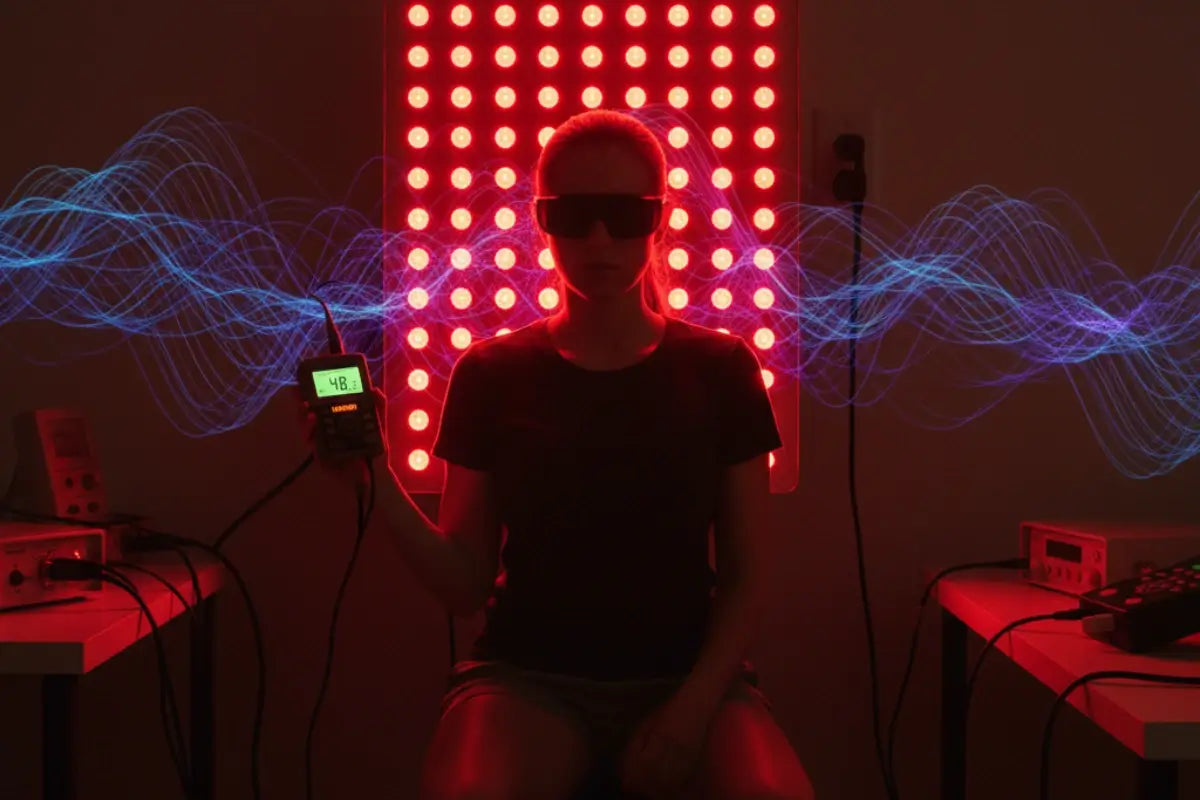Does Red Light Therapy Emit Emf?

Curious about red light therapy and EMF? You’re not alone. Many wonder if these devices are safe for daily use.
The good news: red light therapy emits very low EMF, much less than your phone or Wi-Fi. In this guide, we’ll break down the facts, compare everyday devices, and share tips to stay safe.
Key Takeaways
Red Light Therapy EMF is Minimal: Devices emit very low EMF, much less than everyday electronics.
Safety Standards Matter: Certified devices meet strict international and national EMF regulations.
Household Comparisons: Your phone, Wi-Fi, and kitchen appliances often emit more EMF than red light panels.
Minimize Exposure Easily: Stand back, limit session time, and choose low-EMF devices for extra safety.
“EMF-Free” is Misleading: No device is truly EMF-free; focus on low, safe exposure instead.
Does Red Light Therapy Emit EMF?
Like all electrical devices, red light therapy units, including SYMBYX devices, do emit electromagnetic fields (EMFs).
The important point is that these levels are extremely low, far lower than what you’re exposed to daily from phones, Wi-Fi routers, or kitchen appliances.
SYMBYX devices are also registered health products, meaning they must meet strict international and national safety standards.
These include guidelines from the International Commission on Non-Ionizing Radiation Protection (ICNIRP), as well as agencies like the FDA and European Union.
Such regulations are based on extensive scientific research to ensure EMF exposure remains well below levels that could cause effects such as tissue heating, nerve stimulation, or sensory changes.
In short, while EMFs are technically present, red light therapy devices are carefully designed and regulated to operate safely.
Compared to everyday electronics, their emissions are minimal, giving you peace of mind while benefiting from therapy.

What is EMF?
EMF, or Electromotive Force, is the voltage generated by a source like a battery or generator when no current flows.
It measures energy per unit charge, is expressed in volts, and drives electrons through circuits, with actual terminal voltage affected by internal resistance.
How Red Light Therapy Devices Generate EMF?
Red Light Therapy (RLT) devices generate EMFs because their electrical components, LED drivers, wiring, and fans, conduct current, producing extremely low-frequency fields.
EMF intensity depends on device design, distance, and power level, but properly shielded, low-voltage RLT units emit minimal EMFs, well below safety limits.
Health Risks and Safety Concerns of EMF in Red Light Therapy
EMF Emission: Red light therapy devices do emit EMFs.
Mild Effects: Most users only experience mild, short-term effects.
Long-Term Risks: Serious long-term health risks are still unproven.
Vulnerable Groups: Pregnant women and children should be extra cautious.
Comparison to Household Devices: EMF levels are similar to common household electronics.
Safety Standards: Certified devices follow safety standards for EMF limits.
Comparing EMF from Red Light Therapy to Everyday Devices
Red light therapy devices give off very low EMF
Red light therapy devices emit very little EMF, usually far lower than most household electronics.
Compared to a cell phone, the EMF output is almost negligible. Even Wi-Fi routers give off more continuous EMF than red light panels.
Microwaves and laptops produce stronger fields, especially when used close to the body. Smart TVs and Bluetooth devices also emit higher EMF levels in daily use.
Overall, red light therapy is low risk, and simple practices like keeping a short distance can further reduce exposure, making it safer than many common electronics.
Phones and tablets expose you to higher EMF daily
Phones and tablets constantly emit EMF while in use, often higher than red light therapy devices.
A tablet can emit EMF for hours, especially during streaming or gaming, and cell phones tend to output more EMF than laptops.
Daily use increases exposure, and these levels can add up over time. Placing devices closer to your body intensifies EMF exposure, while keeping a small distance lowers risk.
Monitoring screen time, using speakerphone, and limiting prolonged contact can help manage cumulative EMF exposure from these everyday devices.
Wi-Fi routers constantly emit moderate EMF
Wi-Fi routers continuously send EMF signals, producing more exposure than a single red light therapy session.
Cell phones also add to daily EMF exposure, but routers maintain a constant background level. Smart home devices connected to the same network can increase EMF in a space.
Distance plays a key role, as stepping back from the router or RLT panel dramatically lowers exposure.
Using multiple devices at once can raise EMF levels, so spacing them apart is wise. Red light therapy remains low EMF, and following simple distance rules ensures safe use alongside Wi-Fi and other electronics.
Microwaves and hairdryers produce strong EMF close-up
Microwaves emit strong EMF when standing nearby, and hairdryers generate intense fields during use.
Health risks rise if you remain very close or if the microwave door is damaged. EMF intensity drops sharply with distance, so standing even a few feet away greatly reduces exposure.
For microwaves, keeping a safe distance while operating is effective, and hairdryers should be used briefly and at arm’s length.
Compared to these devices, red light therapy emits minimal EMF, so sessions are much safer. Simple awareness of distance can make all these common devices safer to use.
Laptops on your lap can raise localized EMF exposure
Using a laptop directly on your lap can expose sensitive areas to moderate EMF. Phones and tablets also add exposure, while red light therapy emits very little.
Distance matters, as moving the laptop to a desk or using a lap pad reduces risk. Repeated long-term exposure may accumulate, potentially contributing to health concerns like localized heating or minor cellular stress.
Chronic exposure from multiple devices is more relevant than a short RLT session. Overall, red light therapy provides a low EMF alternative, especially when compared to regular laptop or phone use, making it a safer daily option.
Tips to Minimize EMF Exposure During Red Light Therapy
Identify EMF Sources: Know where EMFs come from in red light devices.
Choose Low-EMF Panels: Buy red light panels with low-EMF ratings.
Keep Distance: Stand a few feet away to reduce EMF exposure.
Limit Session Time: Keep therapy sessions short and moderate.
Optimize Placement: Set up your device in an open, clear space.
Use Shields if Needed: Add EMF shields only if you are extra sensitive.

FAQs
Are red light therapy devices safe regarding EMF emissions?
Red light therapy devices are generally safe regarding EMF emissions, as they emit low-frequency, non-ionizing radiation. EMF exposure decreases sharply with distance, and high-quality, well-shielded devices minimize emissions. Verify third-party testing, avoid low-quality units, and follow recommended distances for safe use.
Can EMF emissions be completely stopped?
EMF emissions cannot be completely stopped, but exposure can be minimized. Methods include increasing distance from sources, using conductive shielding like Faraday cages, fabrics, or paints, turning devices off or to airplane mode, limiting usage, employing corded accessories, and applying filtering or grounding techniques for effective reduction.
Do battery-powered red light devices emit less EMF?
Battery-powered red light therapy devices emit less EMF than wall-powered units because they avoid AC currents, relying on low-EMF chemical energy. Reduced components, no Wi-Fi/Bluetooth, and optional shielding further minimize exposure, while using the device at proper distance and choosing verified low-EMF models ensures safety.
Is “EMF-free” marketing accurate?
The label “EMF-free” is misleading because electromagnetic fields are unavoidable, generated by both natural sources like the Earth and sun, and man-made devices like phones and Wi-Fi. No product can block all EMFs, so such claims exaggerate safety and rely more on marketing than scientific reality.
Does oura ring emit emf?
The Oura Ring emits EMFs via Bluetooth Low Energy for brief syncing or firmware updates, less than 1% of the day. Its power is 1 mW, thousands of times weaker than a smartphone, with a SAR of 0.0003 W/kg. Airplane Mode disables all wireless transmission.
Does the Apple watch emit emf?
Yes, the Apple Watch emits non-ionizing EMF through Bluetooth, Wi-Fi, and cellular connections. While considered low-risk by regulators, prolonged or continuous use may contribute to headaches, fatigue, sleep disruption, or cumulative exposure. Minimizing risk involves Airplane Mode, distance, and moderate use.
Does a fitbit emit emf?
A Fitbit emits a very small amount of electromagnetic fields (EMF), mainly from Bluetooth radiofrequency for device communication and tiny electrical fields from its sensors. The intensity is extremely low, well below regulatory limits, and current research indicates this EMF exposure is negligible and safe.
Does the human body emit emf?
The human body emits electromagnetic fields (EMF) primarily from cellular electrical activity and thermal radiation. Heart and brain signals produce weak magnetic fields detectable by sensitive instruments, while body heat emits infrared radiation. Overall, these EMFs are extremely weak and harmless.





























